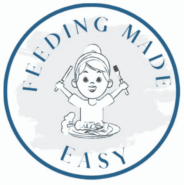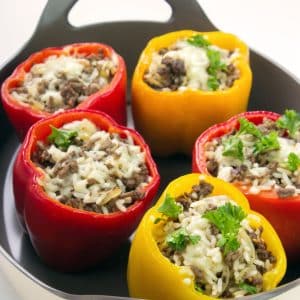Do I recommend bell pepper for baby? YES! Veggies in general can be a tricky texture for babies, so in general, it’s best to start out by cooking them to make them a bit softer then gradually working up to raw vegetables.
Bell peppers have a mild taste which makes them more tolerable to many kids than some of the other veggies, but they still bring a lot of nutrition to the table. They come in a wide variety of colors (way beyond the green, yellow, red, and orange you may see at the grocery store). This is great for variety and for food play opportunities.
While they’re technically in season in the warmer months, they are usually available and relatively affordable year round. It’s always great to have a vegetable that a selective eater will tolerate that is also accessible.
This post may contain affiliate links and when you click on the links I may earn a small commission at no charge to you. As an Amazon affiliate, I earn a commission from qualifying purchases.
Fun Facts About Bell Peppers
- Bell peppers are from the Capsicum genus, but do not produce capsaicin, which is what causes the burning sensation that we associate with spiciness.
- Red bell peppers are just ripe green bell peppers.
- In addition to green, yellow, orange, and red peppers, there are also brown, white, lavender, and dark purple varieties
- Bell peppers are the fruit of the plant, but we commonly use them as a vegetable.
- They are technically berries (a simple fleshy fruit that usually has many seeds, derived from a single ovary of an individual flower) (1).
Bell Pepper Nutrition
Every color bell pepper has slightly different nutrition, but what makes bell pepper great for baby is the high vitamin C levels. A red bell pepper, for example, provides 190 mg vitamin C per cup (2). A 7-12 month old baby only needs 50 mg/day and a toddler only needs 15 mg/day (3). Don’t worry, excess vitamin C is excreted by the body.
Vitamin C is especially important for young kids because it helps improve iron absorption. Iron is a key nutrient for babies and toddlers, but it’s absorption is affected by many factors. Serving foods like bell peppers with iron-containing foods can increase absorption.
Orange, yellow, and red bell peppers are also good sources of beta-carotene. Each color contains antioxidants that help protect the body from damage.
How to Cut Bell Pepper for Baby
For younger babies, it’s best if the bell pepper is served cooked so that it is softer. Once your baby gets a bit older, you can start serving raw pieces.
- Lay the bell pepper on its side. Cut off the stem end and the bottom. Remove any seeds.
- For younger babies without their pincer grasp (usually < 9 months), slice the bell pepper in half, leaving 2 large pieces for your baby to hold onto. You can also cut the bell pepper into long sticks.
- For babies with their pincer grasp, dice the bell pepper into smaller pieces.
- Once your baby is older, you can slice the bell pepper into thin sticks and offer them that way. Encourage your baby to take bites of the sticks by modeling. When they have mastered the sticks, you can offer bigger pieces of raw bell pepper. Continue to encourage them to take bites.
Air Fryer Bell Peppers
Equipment
- 1 air fryer optional
Ingredients
- 1 tbsp oil
- 1 lb ground meat (lean)
- ½ whole onion
- 2 tsp garlic (minced)
- 1 cup broccoli slaw
- 1 ½ cup cooked grain
- 1 can tomato sauce (15 oz)
- ½ tsp Italian seasoning
- 1½ cup mozzarella cheese (shredded)
- 6 whole bell peppers
- 2 tbsp parsley (garnish)
Instructions
- Heat oil in pan. Add in onion. Cook until soft.
- Add in garlic and meat. Cook and crumble until cooked almost all the way through.
- Add in broccoli slaw. Cook until soft.
- Remove from heat. Add in grain, tomato sauce, seasoning, and mozzarella.
- Cut tops off each bell pepper. Cut off bottom to level if necessary. Fill each bell pepper with meat mixture.
- Air fry at 360° for 10 minutes. Add additional cheese on top of each pepper. Then air fry for an additional 2 minutes to melt the cheese. Garnish with parsley.
Notes
Nutrition

Krystyn Parks is a Registered Dietitian and Lactation Consultant who specializes in feeding children. She has a Master’s Degree in Nutritional Science from California State University Long Beach. She is an International Board Certified Lactation Consultant and has been registered with the Commission on Dietetic Registration since 2013.

